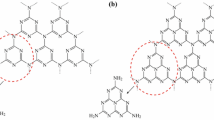Abstract
Fabrication and S-F-codoping of TiO2 nanotubes were carried out by a one-step electrochemical anodization process to extend the photoresponse of TiO2 to the visible-light region. The prepared samples were annealed in air and detected by SEM, XRD, XPS and UV-vis DRS spectrophotometer. The results showed that the average tube diameter of the nanotubes was 150 nm and the average tube length was 400 nm. The doped TiO2 nanotubes exhibited strong absorption in visible-light region. Photoelectrocatalytic degradation efficiency of 4-CP over S-F-codoped TiO2 nanotubes was 39.7% higher than that of only-F-doped sample. Moreover, sulfur and fluorine codoped into substitutional sites of TiO2 had been proven to be indispensable for strong response and high photocatalytic activity under visible light, as assessed by XPS.
Similar content being viewed by others
References
Zhang X W, Zhou M H, Lei L C. Preparation of photocatalytic TiO2 coatings of nanosized particles on activated carbon by AP-MOCVD. Carbon, 2005, 43: 1700–1708
Zhang X W, Zhou M H, Lei L C. Preparation of anatase TiO2 supported on alumina by different metal organic chemical vapor deposition methods. Appl Cata A-General, 2005, 282: 285–293
Asahi R, Morikawa T, Ohwaki T, et al. Visible-light photocatalysis in nitrogen-doped titanium oxides. Science, 2001, 293(5528): 269–271
Li D, Ohashi N, Hishita S, et al. Origin of visible-light-driven photocatalysis: A comparative study on N/F-doped and N-F-codoped TiO2 powders by means of experimental characterizations and theoretical calculations. J Solid State Chem, 2005, 178: 3293–3302
Umebayashi T, Yamaki T, Tanaka S, et al. Visible light-induced degradation of methylene blue on S-doped TiO2. Chem Lett, 2003, 32(4): 330–331
Ohno T, Mitsui T, Matsumura M. Photocatalytic activity of S-doped TiO2 photocatalyst under visible light. Chem Lett, 2003, 32(4): 364–365
Yu J C, Yu J, Ho W, et al. Effects of F-doping on the photocatalytic activity and microstructures of nanocrystalline TiO2 powders. Chem Mater, 2002, 14: 3808–3816
Nukumizu K, Nunoshige J, Takata T, et al. TiNxOyFz as a stable photocatalyst for water oxidation in visible light (< 570 nm). Chem Lett, 2003, 32(2): 196–197
Gong D, Grimes C A, Varghese O K, et al. Titanium oxide nanotubess prepared by anodic oxidation. J Mater Res, 2001, 16: 3331–3334
Ruan C M, Paulose M, Varghese O K, et al. Enhanced photoelectrochemical-response in highly ordered TiO2 nanotubes-arrays anodized in boric acid containing electrolyte. Sol Energ Mater Sol C, 2006, 90: 1283–1295
Quan X, Yang S G, Ruan X L, et al. Preparation of titania nanotubess and their environmental applications as electrode. Environ Sci Technol, 2005, 39: 3770–3775
Ghicov A, Tsuchiya H, Macak J M, et al. Titanium oxide nanotubess prepared in phosphate electrolytes. Electrochem Commun, 2005, 7(5): 505–509
Umebayashi T, Yamaki T, Itoh H, et al. Band gap narrowing of titanium dioxide by sulfur doping. Appl Phys Lett, 2002, 81(3): 454–456
Umebayashi T, Yamaki T, Yamamoto S, et al. Sulfur-doping of rutile-titanium dioxide by ion implantation: Photocurrent spectroscopy and first-principles band calculation studies. J Appl Phys, 2003, 93(9): 5156–5160
Sanjines R, Tang H, Berge H. Electronicstructure of anatase TiO2 oxide. J Appl Phys, 1994, 75(5): 2945–2954
Yu J C, Ho W, Yu J, et al. Efficient visible-light-induced photocatalytic disinfection on sulfur-doped nanocrystalline titania. Environ Sci Technol, 2005, 39(4): 1175–1179
Li D, Haneda H, Hishita S, et al. Fluorine-doped TiO2 powders prepared by spray pyrolysis and their improved photocatalytic activity for decomposition of gas-phase acetaldehyde. J Fluorine Chem, 2005, 126: 69–77
Zhuang H F, Lin C J, Lai Y K, et al. Some critical structure factors of titanium oxide nanotubes in its photocatalytic activity. Environ Sci Technol, 2007, 41(13): 4735–4740
Lee J Y, Park J, Cho J H. Electronic properties of N-and C-doped TiO2. Appl Phys Lett, 2005, 87(1): 011904
Batzill M, Morales E H, Diebold U. Influence of nitrogen doping on the defect formation and surface properties of TiO2 rutile and anatase. Phys Rev Lett, 2006, 96(2): 026103
Author information
Authors and Affiliations
Corresponding author
Additional information
Supported by the National Natural Science Foundation of China (Grant Nos 90610005, 20576120, 20336030 and U0633003), the National “863” Program (Grant No. 2007AA06Z339), and Science and Technology Bureau of Zhejiang Province (Grant No.2007C13061)
About this article
Cite this article
Chen, X., Su, Y., Zhang, X. et al. Fabrication of visible-light responsive S-F-codoped TiO2 nanotubes. Chin. Sci. Bull. 53, 1983–1987 (2008). https://doi.org/10.1007/s11434-008-0279-4
Received:
Accepted:
Published:
Issue Date:
DOI: https://doi.org/10.1007/s11434-008-0279-4




